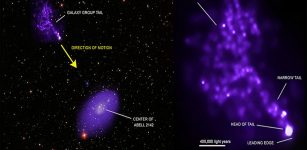Debris From Kepler’s Supernova Travels At Speeds 25000 Times Faster Than Speed Of Sound On Earth
Eddie Gonzales Jr. – MessageToEagle.com – Using NASA’s Chandra X-ray Observatory, astronomers recorded debris blasting away from the site of an exploded star at speeds 25,000 times faster than the speed of sound on Earth.
In 1604, astronomers, including Johannes Kepler saw the supernova explosion that destroyed the star. Kepler’s supernova remnant is the debris from a detonated star that is located about 20,000 light-years away from Earth in our Milky Way galaxy.
 Credit: NASA/CXC/Univ of Texas at Arlington/M. Millard et al
Credit: NASA/CXC/Univ of Texas at Arlington/M. Millard et al
The team tracked the speed of 15 small “knots” of debris in Kepler’s supernova remnant, all glowing in X-rays. The fastest knot was measured to have a speed of 23 million miles per hour, the highest speed ever detected of supernova remnant debris in X-rays. The average speed of the knots is about 10 million miles per hour, and the blast wave is expanding at about 15 million miles per hour.
Researchers in the latest study estimated the speeds of the knots by analyzing Chandra X-ray spectra, which give the intensity of X-rays at different wavelengths, obtained in 2016. They also used Chandra images obtained in 2000, 2004, 2006, and 2014 to detect changes in the position of the knots and measure their speed perpendicular to our line of sight. These two measurements combined to give an estimate of each knot’s true speed in three-dimensional space. A graphic gives a visual explanation for how motions of knots in the images and the X-ray spectra were combined to estimate the total speeds.
The high speeds in Kepler are similar to those scientists have seen in optical observations of supernova explosions in other galaxies only days or weeks after the explosion, well before a supernova remnant forms decades later. This comparison implies that some knots in Kepler have hardly been slowed down by collisions with material surrounding the remnant in the approximately 400 years since the explosion.
Based on the Chandra spectra, eight of the 15 knots are definitely moving away from Earth, but only two are confirmed to be moving towards it. (The other five do not show a clear direction of motion along our line of sight.) This asymmetry in the motion of the knots implies that the debris may not be symmetric along our line of sight, but more knots need to be studied to confirm this result.
The four knots with the highest total speeds are all located along a horizontal band of bright X-ray emission. Three of them are labeled in a close-up view. These four knots are all moving in a similar direction and have similar amounts of elements such as silicon, suggesting that the matter in all of these knots originated from the same layer of the exploded white dwarf.
One of the other fastest-moving knots is located in the “ear” of the right side of the remnant, supporting the intriguing idea that the three-dimensional shape of the debris is more like a football than a uniform sphere. This knot and two others are labeled with arrows in a close-up view.
The explanation for the high-speed material is unclear. Perhaps Kepler’s supernova remnant is from an unusually powerful Type Ia, which might explain the fast-moving material, or the immediate environment around the remnant is itself clumpy, which could allow some of the debris to tunnel through regions of low density and avoid being decelerated very much.
Written by Eddie Gonzales Jr. – MessageToEagle.com Staff










